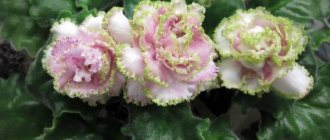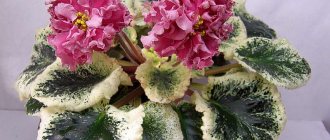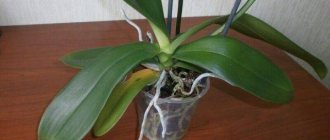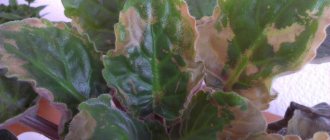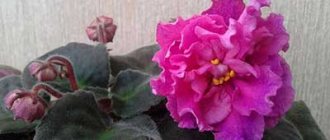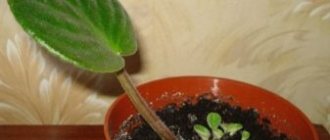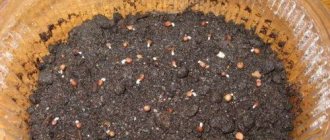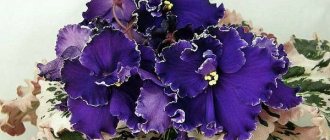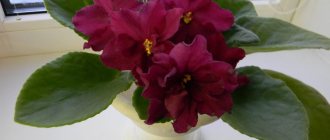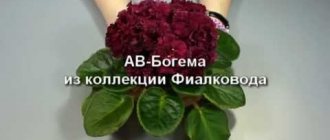Indoor plants help create coziness in the house, and violets will be irreplaceable in this case. Small, neat bushes with bright flowers look very cute and touching. The richness of the choice of varieties is amazing, but the “Maria” violet will definitely attract your attention thanks to its voluminous double inflorescences, somewhat reminiscent of a star shape, and unusual coloring. Despite its somewhat exotic appearance, this purple color is quite unpretentious. How this plant appeared and how to care for it is what we will talk about in this article.
Violet - the queen of window sills
There are a large number of varieties of violets, which differ from each other in the shape of the flower and leaves. This variety allows you to choose the most suitable variety that will fit perfectly into the interior of the room. But experienced flower growers know that the Maria violet is suitable for everyone.
All gardeners dream of growing violets. This plant is unpretentious, and after a short time it will delight you with long, abundant flowering.
The best varieties of violets with descriptions, names and photos
The most common indoor plant is the Usambara violet or Saintpaulia; it can be seen in almost every home. This flower is practically unpretentious and blooms all year round, and the variety of varieties allows you to create a real garden on the windowsill. Plants differ in shades, flower shapes and compact sizes; every year the list of varieties is replenished thanks to the efforts of breeders. A variety of violets, varieties with names and photos can be found in flower catalogs and stores.
Origin and characteristics of the flower
The flower was first discovered in 1892 in eastern Africa by Governor and Baron Adelbert Walter von Saint-Paul during an afternoon walk. Noticing an unusual purple flower, he collected the seeds and sent them for research to his father in Germany, who forwarded the parcel to the director of the botanical garden in Hanover, who examined the plant and named it part of the Gesneriaceae family .
History of the violet
Violet is an annual or perennial plant. The flower belongs to the Gesneriaceae family. In nature, this flower prefers to grow in the mountainous regions of Africa. This plant is widespread throughout the globe. The minimum requirements for growing conditions are what the indoor violet “Maria” is valued for. The main thing is to create optimal conditions for growth.
They began to grow violets as a houseplant only in the 20th century. During this time, breeders have created many species that delight the eye with their appearance.
But T. Dadoyan gave flower lovers an unforgettable variety of violet “Maria”. The flower is characterized by large, densely double corollas. This variety can truly be called a highlight. The breeders tried to combine all the best in it: a corrugated frill along the edge of the petals, a fantasy pattern of amazing shape. The flower itself resembles a small rose. Maria violet is a luxurious variety with a bright green rosette and attractive pink flowers.
Violet LE-Maria-Mirabella (E. Lebetskaya)
The terry two-color bordered variety LE Maria Mirabella is of interest to lovers of Saintpaulia. Bright pink pompoms with speckled borders on tall peduncles are highly decorative.
Genus, family
Maria Mirabella is a variety of Uzambara violet, belongs to the family. Gesnerievs, Saintpaulia family.
History origin
Violet Maria Mirabella was bred in 2015 by E.A. Lebetskaya . The famous Ukrainian breeder is the author of more than 250 varieties of Saintpaulia.
Photo and description of the variety
Maria Mirabella violet is a plant with a standard neat rosette of light green leaves, slightly wavy at the edges.
It blooms with dark pink double flowers with a speckled, ruffled crimson border. The violet flower is 4-6 cm in size, the specks on the tips of the petals darken over time, acquiring a lilac hue.
Variegation, imprints
The Maria Mirabella variety has a compact, monochromatic rosette of light green leaves; there are no prints on the petals.
Sports
A violet whose flowers or foliage differs from the mother plant is called a sport. Sports varieties Maria-Mirabella tend to have paler flower colors , sometimes on the same bush you can see buds painted in different shades of pink.
The most famous sport variety has white, double, pompom-type flowers with a speckled pink ruffled border.
Description of the variety
All flower growers know that you cannot stop at one variety of violets. After all, you immediately want to buy a few more beautiful, fluffy and bright plants. Therefore, before purchasing, it is advisable to read the description of the “Maria” violet. This is a fixed sport from the “fairy” variety.
This variety is characterized by densely double flowers, which remain in the form of “heads of cabbage” for a long time in bloom. The petals are white, with a pink tint. Along the edge there is a raspberry-colored border with sputtering and a thick green ruffle. The flowers are large, voluminous, up to 6 cm in diameter. Green ruffle appears in 2-3 blooms. The brightness of the color is affected by the ambient temperature.
The leaves are standard: wavy, rich green. The rosette has curly, wavy leaves that “spin” it. The rosette is loose, the petioles are long. An interesting fact is that when growing a variety on a shelf, the leaves rise up. But if the pot is on the windowsill, all the leaves fall behind the pot. This growth feature directly depends on lighting.
The variety is not early ripening and grows slowly. The Ave Maria violet loves light. Experts recommend bringing several plants to flower at once, because sports often occur. But flower growers claim that all flowering options are beautiful.
The variety is characterized by a long flowering period. The inflorescences do not fade for a long time. Peduncles easily hold large, full heads of cabbage. This variety is unpretentious, produces many children, and grows quickly.
Many people think that the Hail Mary violet is a very sporty one. “Maria” when it blooms, one plant can have 2 peduncles that differ from each other. The main color in the flowers of this variety should be light.
Violet Maria: cultivation
Violet Maria: photo of the variety
When Maria Dadoyan’s description of the violet indicates that it is unpretentious, this does not mean that you don’t have to care for the flower at all. This only indicates that if the necessary conditions are created, the plant will develop well and regularly delight you with its flowering. Let's discuss exactly what conditions need to be created for violets of the Maria variety:
- do not take a pot that is too small, because despite the slow growth of the above-ground part, the violet grows roots quite quickly, so even for a young plant you should take a container with a diameter of at least 10-12 cm. The flower pot can be either plastic or ceramic, the main thing is - the presence of a drainage hole in the bottom of the pot.
- The ideal option would be to place a flower pot with a violet on an eastern or western windowsill - this way the plant will receive enough light, but will be protected from direct scorching rays. When placing a plant on a windowsill, do not forget to periodically turn it so that light comes in from all directions and the plant does not pull in one direction. If you are an experienced gardener and have a phytolamp on your farm, then you can place the violet under it.
- the air temperature in the room where the violet is located should be within +18...+22 degrees.
- In addition to direct sunlight, which can leave burns on the leaves, you should be wary of drafts - this rule is true for any variety of violets.
- do not experiment with soil; if possible, purchase ready-made soil for Saintpaulias. If you prefer to prepare the soil mixture yourself, then mix leaf soil with peat and sand, adding a little baking powder (fine expanded clay or vermiculite).
Plant propagation methods
All gardeners want to grow their own violet on their windowsill. This is quite easy to do. Violets can be grown in several ways:
- cuttings;
- stepsoning;
- propagation by seeds;
- propagation by peduncles.
Violet lovers recommend propagating the plant at home by leaf cuttings or pinching.
Features of flowering, growth and reproduction
The Maria Mirabella variety belongs to the standard type , the rosette of an adult plant is 15-20 cm wide.
Development at home
In the first year of life, Saintpaulia forms a rosette of leaves , then the violet begins to bloom. Gradually, some of the leaves die off and the lower part of the stem is exposed. The plant loses its decorative effect. Violets are periodically propagated vegetatively to produce young plants or rejuvenated.
How long does it take to grow an adult plant?
Young seedlings obtained as a result of rooting become adults in about a year. At the same time, the first violet bloom is expected.
The first flowering occurs at the age of one year.
Features of flowering in hot and cool conditions
The most luxuriant flowering is observed in summer. The buds open faster, the speckled edging darkens day by day. In autumn and spring, violet blooms less profusely, but the flowers do not fade longer.
How are varietal characteristics transmitted?
LE Maria Mirabella is prone to the formation of sports when propagated by leaves. It is possible to obtain a violet while preserving the color of the mother plant by planting stepsons or propagating by peduncles.
Step-by-step instructions for propagation by peduncles:
- the stem with the flower is cut off from the bush, a cut is made along an oblique line at a distance of 1 cm from the stipules;
- the buds are removed, leaving stubs of 3-4 mm;
- the cuts are sprinkled with crushed coal;
- the peduncle is buried in the soil to the level of the stipules;
- A mini-greenhouse is installed above the pot.
On a note! Place the container in a bright place, but not in direct sunlight.
What do flower stalks look like?
The variety puts forward tall inflorescences on which 2-3 buds are formed . Large double flowers, 5-6 cm in diameter, do not bloom at the same time.
Is it possible to achieve cap flowering?
The Maria Mirabella variety is prone to abundant bouquet flowering. The following methods will help you to ensure that Saintpaulia blooms:
- formation of a not too dense leaf rosette;
- obtaining tall peduncles by moving the flower to a place with less light;
- timely removal of stepsons and weak inflorescences.
LE Maria Mirabella is prone to the formation of lush flower caps.
Cap flowering occurs in summer. In early spring and autumn, violet blooms less luxuriantly.
Bud lifespan
The flower of the Maria Mirabella variety takes a long time to bloom and stays on the peduncle for 7-10 days . In spring and autumn, the buds do not fade longer, but the largest flowers appear from June to August.
Violet cuttings
This method is most often used at home. In this case, rooting occurs almost 100%. But when growing “Virgin Mary” violets, you should remember that this variety is highly athletic. Therefore, no one can guarantee that a flower grown from a leaf will have the same flowering characteristics as the mother plant.
- Carefully cut a strong leaf from a healthy mother plant at an angle.
- The leaves are rooted both in water and in soil or a peat tablet.
- The cut leaf should be rooted immediately.
- You can create greenhouse conditions for it using a glass.
- After some time, babies will appear on the cuttings. At this stage, you should carefully remove the leaf.
- Under favorable conditions, the violet will bloom in 1 year.
Reviews
Saintpaulia lovers appreciated the varietal characteristics and appearance of terry violets.
Natalya Ivanova, 37 years old, Moscow region. “I bought a rooted stepson of the Saintpaulia variety Maria Mirabella at an exhibition in Moscow. The collector presented an adult bush of profusely blooming violet. There were so many flowers that the leaf rosette was not visible. I loved the rich color and speckled lilac trim. The variety is unpretentious and grows well at home. After 9 months, the seedling bloomed for the first time.”
Irina Maleeva, 56 years old, Vologda. “I purchased a violet leaf of the Maria Mirabella variety from a collector, sent by mail. The cutting took root well, and a year later the first flowering began. The colors of the buds were slightly different from those presented in the catalogue. One inflorescence turned out to have deep pink flowers, the other one was much paler. In general, this does not spoil the appearance of the bush at all; the terry stars are very large and do not wither for a long time. I was satisfied with the variety.”
Reproduction by stepson
This method is excellent for propagating the Maria violet variety. After all, it guarantees that the new plant will inherit all the maternal qualities.
- We choose a strong mother plant.
- The stepson must have more than 3 leaves.
- Carefully cut off the stepson with a sharp tool. You can use an awl or a sharp knife. At the same time, be careful not to injure the main rosette of the violet.
- For rooting, you can use a peat tablet or soil purchased in advance from the store.
- In order for the stepson to quickly take root, greenhouse conditions should be created within 1 month.
Violet description and photo Maria (T. Dadoyan)
Violets from breeders of the CIS countries - “M-3”.
Maria (T. Dadoyan).
Densely double flowers remain in the form of “heads” for a long time in bloom. The petals are white with a slight pink tint, along the edge there is a crimson border with a dusting and a thick green ruffle. Curly, fixed sport from the Fairy variety (T. Dadoyan).
The leaf is medium green and wavy. Standard. The rosette has a wavy, curly leaf and it twists. On a shelf, the rosette lifts the leaves up, on the windowsill it lowers them behind the pot, you need to select the lighting individually. The rosette is loose with long petioles.
Large, heavily double flowers with a crimson coating and green ruffle. The flowers are large and voluminous. Green ruffle is obtained in 2-3 blooms. Keeping them in warm or cool conditions makes a huge difference in color brightness. Flower size up to 6 cm.
It does not grow quickly, nor is it an early ripening plant. The plant loves light. It is advisable to bring several plants to flowering, because... sports happen quite often. True, all flowering options are beautiful.
Blooms abundantly, flowers do not fade for a long time. The flower stalks hold their large, full heads of cabbage quite easily. The variety is not whimsical, grows quickly, produces a lot of children.
A very sporty variety, it is very rare to get plants according to the variety. On the same plant and even on the same peduncle, flowers can differ significantly from each other. Even from the Fairy's stepson a sport grows, and from Maria's leaf grows two plants of different colors, but neither of them resembles Maria.
When propagated, the Fairy variety produces a lot of curly hair (from practice, approximately 50x50). Often such sports are written as Maria. From the Fairy who gives sports, many “pseudo Marias” proliferated, illegally called Maria. It turns out that they are trying to call all the beautiful sports from Fairy the Maria variety.
Maria is the same Fairy, but with flowers (roses) and wavy leaves. Maria has a flower head with a crimson border and a green ruffle. For the Maria variety, the main color of the flower should be light. Except for the leaves, it is practically no different from the mother variety Fairy. There are sports that easily go into primary grade and back. Either in a class or in a sport.
Maria (Marya) - the name comes from the Hebrew name Mariam (Maryam). Orthodox tradition translates the name Mary as “lady.” According to traditional Christian beliefs, Mary was the name of the mother of Jesus Christ.
Do you know that…?
The mutational variability of violets is unpredictable and is inherited, that is, it has irreversible consequences in the form of sports. Mutational variability, in contrast to modification, is individual (affects individual organisms) and uncertain (unpredictable) in nature. In violets, the color of flowers and leaves most often “sports”; changes in the shape of plant organs are less common. Violet lovers are familiar with it from the origin of the sport. Sport is a spontaneously occurring, stable genetic disorder. These are random, abrupt changes in the appearance of plants, which, having occurred once, are passed on to offspring. This means that the sport will never be able to become a variety again - neither with the passage of time, nor if an attempt is made to propagate such a plant in any way. This is caused by changes in the hereditary information encoded in the plant's DNA.
Before you buy the violets listed below, carefully read the forums about their behavior on the windowsill. Many of them are very beautiful flowers. However, these can be large rosettes with large and fragile leaves, with leaves rising up or hugging the pot, forming many stepsons that interfere with the formation of a neat rosette, pulling the stem up and growing into a Christmas tree, bending the trunk, rare flowering with long breaks, fallen flowers or they last little and quickly wither, very long and recumbent peduncles, the color of the flower fades quickly, they do not like bright lighting on the windowsill, they are afraid of the slightest drying out or waterlogging, a large percentage of them go into sports or darken the flower.
Are they suitable for your window sill and the conditions that you can create for them? You will look at the flowers for several months, and the rosette will always be in front of your eyes. There are many beautiful flowers, there are much fewer beautiful and neat rosettes, look first at the rosette! Search and you may find a dozen violets with the same flower color if you are not interested in the smallest details as a collector.
• — Magic (Makuni); • — Makstroem (Makuni); • — Margosha (Fedorchenko); • — Maslenitsa (Dadoyan); • — Matilda (Volskaya); • — Mashenka (Pugacheva); • — Dream (Kolesov); • — Mirshtanti Gulbe (Butene); • — Sea Breeze (Ivanova); • — Sea Myth (Arkhipov); • — Muller (Makuni);
Watering
Proper watering of violets is the basis for long-term and high-quality development of the plant. It should be moderate; experts recommend watering the plant twice a week. Both upper and lower methods are used.
The top method of watering involves filling the pot with water over the edge, making sure that the water does not get on the surface of the leaves. This is not a very effective method, since the soil is moistened unevenly.
Bottom watering involves placing pots with plants in a tray of water, to which fertilizer is often added.
You need to water with settled and heated water.
Violet Maria: care
Violet Maria: photo of the variety
The most important part of violet care is watering. It is recommended to water the Maria violet twice a week (of course, following this recommendation, you need to take into account the air temperature in the room and, if necessary, edit the watering regime). You can water the plant in the usual way, but since violet leaves do not like contact with water, it is better to pour water into the tray and wait until the plant absorbs as much moisture as it needs. Water for irrigation must be left to stand for several days without covering it with a lid. The water temperature should be at room temperature. It is strictly forbidden to water plants with cold tap water.
During the flowering period, violets will definitely need to be fertilized with special fertilizers for Saintpaulias (they can be purchased without any problems at large flower shops, greenhouses or garden centers). With the end of flowering, fertilizing is stopped, and the amount of watering is also reduced during the winter months. But the Maria violet will still need long daylight hours, so you will need additional lighting in the morning and evening hours.
Maria (T. Dadoyan)
Moderator: Floriana
Maria (T. Dadoyan)
Post by Elena M. » 02 Dec 2013, 23:57
Saintpaulia Maria. Breeder T. Dadoyan.
While at the exhibition I saw a copy of the Saintpaulia variety Maria. The owner of the plant is Lyudmila Lysenko. She told me that this is exactly the kind of Mary she should be. The photo shows the second generation of the variety. It was received from an outlet that Tatyana Lvovna Dadoyan personally approved and named Maria. The second generation fully conveyed the varietal characteristics of the source material. After asking Luda’s permission, I decided to show this copy on the forum. Many will now have the opportunity to distinguish the real Maria from other “pseudo Marias” that have bred as a result of various sports from the Fairy and are illegally called Maria.
Re: Maria (T. Dadoyan)
Post by Din-don » 04 Dec 2013, 09:29
Re: Maria (T. Dadoyan)
Post by Yalo » Dec 20, 2013 07:47 pm
Dear Tatyana Lvovna. (if you came here) I have one more big request for you. I hope that collectors will also support me in this. Please give a description of the “Maria” variety, which is a sport from your “Fairy” variety. Even the two plants exhibited by Lyuda Lysenko, whose sport was given the status of the “Maria” variety, and one of which was a descendant of that very first rosette, are quite different from each other. What can we say about plants grown in other conditions? Even warm-cold will make a huge difference in the brightness of the color (white-colored). The children grown from varietal cuttings also had (for me) a completely different appearance.
When propagated, the Fairy variety produces a lot of curly hair (from practice, approximately 50x50). Often such sports are written as Maria. Only your description will allow you not to rack your brains every time about what the collector brought to the exhibition.
Re: Maria (T. Dadoyan)
Post by Tatyana L. » Dec 20, 2013, 07:49 pm
Dear Olga Viktorovna, first about the Fairy. How was the Fairy variety created? You know, I started - our entire group “Moscow Violet” continued. Thank you and all the girls. Whether we succeeded or failed to do something, I don’t know, if it’s 50/50, as you say, probably not entirely.
As for Maria, once at an exhibition at Lyuda Lysenko’s I saw sports from the Fairy. Lyuda asked permission to check it for grade. I liked the flower and agreed, asking that if she succeeds in checking this specimen for repetition of varietal characteristics, name the violet Maria. She worked with this sport, she knows better, and ask her questions about the description. And as you know, I haven’t been working with violets for two years now. Unfortunately. I would like to thank you, Olga Viktorovna, and all our girls for your kind and warm attitude towards me. Thank you.
Re: Maria (T. Dadoyan)
Post by Elena M. » Dec 20, 2013, 10:26 pm
Re: Maria (T. Dadoyan)
Post by Liliya Fedoseeva » 24 Feb 2014, 15:01
This is what happened to me
Re: Maria (T. Dadoyan)
Post by Elena M. » 24 Feb 2014, 15:20
Reproduction
To grow “Maria” yourself, you do not need to have special skills and knowledge. Everything is quite simple and easy. There are such methods of reproduction as:
- cuttings;
- propagation by seeds and peduncles;
- stepsoning.
For “home” propagation, it is better to use methods 1 and 3. When cutting violets, rapid rooting occurs. This method involves the following steps:
- cut off a large healthy leaf on the “mother” plant;
- we root it in a small container with water or in loose soil (at a depth of no more than 2 cm);
- We are waiting for the “babies” to appear on the sheet (the process lasts up to 2 months);
- When roots form (1–2 cm), plant the plant in the ground.
Another effective method of propagating violets is pinching. It looks like this:
- we make a choice in favor of a healthy “mother” plant;
- we find the stepson (it should have no more than 3 leaves) and cut it off using a sharply sharpened knife;
- We act carefully, trying not to touch the main outlet of “Maria”;
- we root the stepson; a peat tablet or potting soil will do;
- we create greenhouse conditions for it for 1–1.5 months;
- As soon as rooting occurs, we plant the plant in the ground.
A review of the violet “LE Maria Mirabella” awaits you in the video below.
